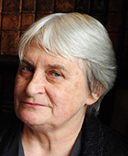Sir Misha Black Medal for Distinguished Services to Design Education
Joe Kerr, who represents the Royal College of Art on The Awards Committee, read the citation for Margaret Calvert OBE, RDI:
“Distinguished guests, honorands of the Sir Misha Black Awards – past and present – Madame Chair, it is an extraordinary privilege to deliver this citation for a medal recipient whom I admire both on a professional and personal level. The great joy of the Sir Misha Black Awards is that in this ceremony we not only the great design and education achievements of the medal winner, but we also get to enjoy them in person, as it is a mandatory condition of acceptance that they turn up to talk to us about their work and their career. In the case of tonight’s medallist that is a particular pleasure, as I know from long acquaintance that she is as modest and self-effacing about her own achievement, as she is brilliantly talented and creative.
But I do face a significant and unprecedented challenge in presenting our medal-recipient to this audience. In the past, there have recipients of the Sir Misha Black Medal, whose work was not familiar to all present, and required some introduction. There have been others for whom that horribly over-used phrase “so-and-so needs no introduction”, whilst rather cliched, was perfectly true. Well, I guess that tonight's winner would fall into that category, and most of you I'm certain will be familiar with her work, but it is ladies and gentlemen a question of degree; thus a bigger challenge than simply recognising her work, would be to consider how on earth one could possibly avoid it! I'm being quite serious, for has there ever been a designer, in a British context, whose output is more ubiquitous, of greater utility, and more deeply embedded in our quotidian experience than Margaret Calvert’s? Ladies and Gentlemen, we’re absolutely surrounded with the stuff! As I travelled here today, I realised that I could hardly get beyond my own doorstep without bumping into an authentic Calvert, and then when I arrived here, having encountered many dozens more, I couldn't even enter the building without passing under yet another example of her typeface design. And what is more, Ladies and gentlemen, you too will have had the same experience, today and pretty much any other day you’d care to mention! Indeed her work is so visible, and so ubiquitous, that I would venture to claim that her work is now an indivisible and inextricable component of the British landscape.
At this point, before our medal recipient takes in on herself to protest, I must insert a vital caveat, for although tonight we are honouring Margaret Calvert, and it is her work that I am addressing in this citation, it goes almost without saying that for many of her most celebrated works we are actually talking about the achievements of the design office Kinneir Calvert Associates. I learnt many years ago when interviewing Margaret for a radio programme about her work, that she will always absolutely insist on a proper credit for her teacher, mentor, and ultimately professional partner, the late Jock Kinneir. So his presence hovers over tonight’s proceedings, and we acknowledge his extraordinary achievements, but tonight we are honouring Margaret Calvert, one of our most important and influential living designers, and what is more a pioneering woman in a traditionally male-dominated branch of the design profession.
And so what of the work? I once wrote of the work of Kinneir Calvert that they created the corporate identity of the welfare state. Whilst the story is inevitably more complicated and nuanced than that, nonetheless it does point to the extraordinary contribution that they made to our visual landscape from the late 1950s onwards. British Airports, British Railways (in conjunction of course with the DRU), Tyne & Wear Metro, and most spectacularly of all, the new Motorway signage, followed by the signs for all other roads as well, placing their work on every street, often only inches apart, from Lands End to John O’Groats – as of 2013 there were an estimated 4.57 million road signs in the UK. It’s hard now for us to reconstruct the extraordinary impact that those huge signs must have had on our tired, dirty, worn-out post-war world. We now speed along our mortorways with scarce a thought for those huge sheets of blue-painted metal, with their sparse but elegant assemblages of simple pictograms and abstracted pencil-point arrows; we only look at the information they contain rather than consider them as objects, but we should not forget that when these vast objects first reared up against the sometimes blue sky, they were by far the largest signs that had ever been erected. Margaret tells the story of how Jock had to purchase his first car in order for them to attend the opening ceremony for the first stretch of the M1 – neither of them had previously owned one! – but when they set off through this new landscape of leviathan earthworks, colossal viaducts and of course enormous signs, they were so enthralled they arrived at the end of the motorway, and realised that they had missed the opening ceremony altogether!
But their enduring legacy lies not just in those billboard-sized signs in blue and green, but even more so in their contribution to the small-scale signage of our road system. It is perhaps ironic in the year of Brexit that we should celebrate the designer of our pantheon of roadside pictograms, because the UK’s adoption of the 1949 Geneva Protocol on Road Signs and Signals, which specified both the shape and the symbol for each road sign, was intended as a deliberate prelude to membership of the Common Market! The story that most people know, and the one that adds an endearingly personal and human dimension to the story of this great universal design achievement, is that of the Children Crossing sign, whilst the biggest smile is always raised by the man opening an umbrella sign – I’m sure Margaret wishes to this day that she had put a handle on the shovel!
However as you know, the Misha Black Medal is not awarded on the basis of design excellence, but “for Distinguished Services to Design Education”. Now of course we have always taken the most liberal interpretation of education in considering eligibility to the award, and as Mary Mullin astutely pointed out to me, Margaret Calvert’s work can be seen as didactic in the broadest and most universal sense – information design is there for the precise purpose of educating the public. But even without that most catholic understanding of education, Margaret is a richly deserving winner, because of course she dedicated a significant portion of her career to teaching, ultimately becoming head of graphic design here at the RCA – and I am particularly proud to be saluting a former colleague here tonight. Margaret, welcome back to familiar surroundings!
When I first became enthralled with the work of Kinneir & Calvert, their appreciation was generally limited to design afficionados, such as yourselves ladies & gentlemen, who nonetheless were unstinting in their praise of one of the most successful and most universal modern design project ever undertaken in this country. By and large the general public passed by those ubiquitous signs without giving them a passing thought – which is of course precisely the point – successful signage should not draw attention to itself, it should just perform its vital function.
But in recent years, her star has risen ever higher in the great constellation of design. This year alone, Margaret has been appointed an OBE, and awarded an honorary doctorate by the Royal College of Art. And in terms of popular appreciation she is, I would venture to guess, alone amongst the galacticos previously awarded the Sir Misha Black Medal, to have been a guest on Top Gear! But as Mary has said, this is the only award in the world for service to design education, and thus it adds a new dimension to the wider appreciation of Margaret’s magnificent achievement.
It was I think Margaret herself who once described her specialist field of work as being the cinderella of the design world, and you must understand that that was not intended as a complaint. But tonight ladies and gentlemen I am delighted that this particular cinderella is the guest of honour at her own ball, and it gives me both pride and pleasure to commend to you Margaret Calvert OBE, recipient of the 2016 Sir Misha Black Medal !”





